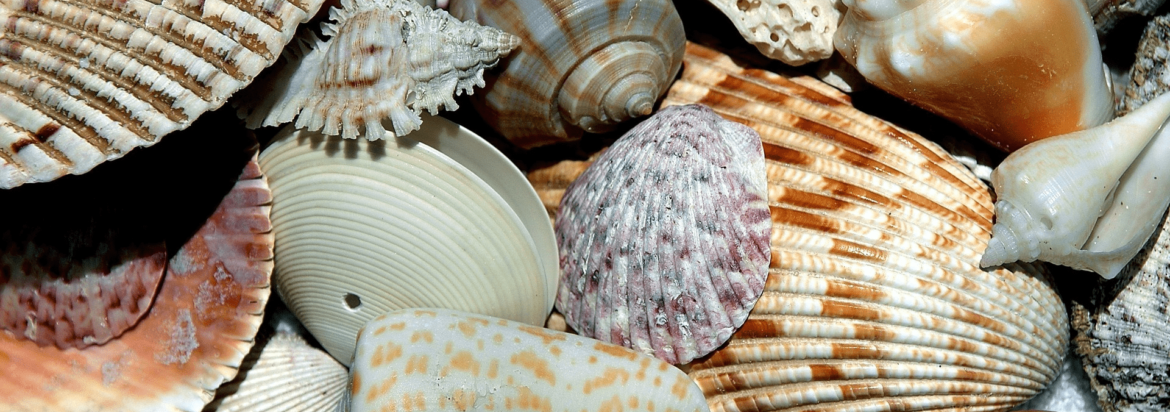What is it about seashells that draw people to them? What gives them their ancient mystery and magic?
When I ask my daughter-in-law if she wants me to grab her a shell bag in preparation for our beach walk, she quickly raises her hand as if I’d offered a dieter a second serving. “No, I’m trying to be good.” She slips into her beach shoes. “I won’t rush you, though,. Take all the time you want to look.”
My son accompanies us on our beach walk in Gulf Shores, Alabama, where creative kids are building unique sand structures, college-age spring breakers are tossing footballs and playing spike-ball, and mesmerizing waves are rolling in. Entertainment is all around, but I’m staring at the sand searching for shells. Other people are too.
Knowing how addictive shell collecting can be, I take along an extra bag for her. Just in case.
As we walk the beach, I scan the other people carrying bags. My competition. Shell collecting addicts are easy to spot not only because of their bags, but the intense look on their faces.
“Oh, look at this one.” My daughter-in-law has a glint in her eye. She shows me a solid piece of eastern oyster that is nearly iridescent—and irresistible.
“Beautiful,” I say, and hand her a bag.
My son brings up the question of where these shells lived before they washed ashore. Were they all happily cruising along, living their lives in a quiet bay before they died? Had some of these shed the shell and grown a new one?
I ponder the question of what may have caused the creatures to die. Was it mainly that predators ate them, or was their life cycle simply over?
The first shell I place in the bag looks like a small conch shell. My research later that night will reveal it’s s a pear whelk. While I was still teaching, I used to bring in my giant conch shells and allow the fourth-graders to hold one up to their ear and listen “to the ocean.”Afterward, we discussed how it wasn’t the ocean they heard, but the vibration of sound in the room. If handed a giant conch shell today, I would automatically hold it to my ear, fascinated as ever.
The second shell is a perfectly formed scallop in a soft hue of orange and red. Scallops, I later see thanks to YouTube, are shockingly fast and can do crazy stunts like flip over. How fun it would be to snorkel near a scallop bed and try to catch them.
My third shell is a whimsical old maid’s curl, or worm shell. It’s curled and twisted like a funky corn curl and seeing it lightens the heart.
I’m not lucky enough to find a whole white sand dollar, but I pick up a small green one. Sand dollars aren’t shells but the outer skeleton or echinoderm of the creature who made it, similar to a sea urchin or starfish. They don’t get white until the animal dies. The sand wears off the fuzzy outer coating and the sun bleaches them.
Beach sand swirls around in the ocean breeze as I bend down for my fifth shell, a complete Atlantic coquina that is a soft yellow and the perfect size for earrings. It’s rare to find a coquina still hinged, so I carefully add it to my bag hoping it remains so. I enjoy the various colors of the coquinas and find a lavender one to collect as well.
When I find a nearly whole cowrie shell, I feel like I’ve won the lottery. This one is a pretty salmon and rust color. Cowrie shells are believed to be the first currency used by native Africans, so from ancient time, people have been drawn to the beauty and mysteries of shells.
Maybe it’s because collecting shells allows us to claim a bit of the mystery of the sea for ourselves. We can imagine ourselves as strong and attractive as an oyster shell, as fascinating as a conch held to the ear, as energetic or athletic as a scallop, as whimsical as an old maid’s curl, as popular as a perfectly formed sand dollar, as perfectly balanced as a hinged coquina, or as valued as a cowrie.
Shell collecting. A way for us to claim the beauty, wonder, and mysteries of the sea.


5 Replies to “The Mysteries of the Sea”
I love collecting shells. I recently read a great NFiction book for adults about the history of shells. I’ll look for the title and add it when I find it.
I love walking the shoreline looking for shells when I’m near the ocean. I hope I’ll get many more opportunities to do that. It’s such a peace-filled experience!
My family and I also love collecting shells. We have a lot of luck finding sand dollars on the Gulf in Florida. It’s mesmerizing and relaxing w/ that fun feeling of accomplishment of finding that perfect shell!
Hi Sue,
I have fond memories of walking the beach with you in Sarasota. Lovely.
I am also an addict and something I have no desire to recover from!